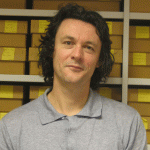Scott & Trowell – Question 3
By
Clare Scott, Ian Trowell
April 2014
3How do you reconcile originality or creativity with values and practices often central to archival representation such as “authentic” or “faithful” representations of source materials and respect des fonds?
Clare Scott
Faculty of Arts and Humanities Librarian – University of Sheffield
Ian Trowell
Collections Manager for National Fairgrounds Archive, Western Bank Library – University of Sheffield
¶ 1 Leave a comment on paragraph 1 0 From the point of view of our archival collections at the National Fairground Archive (NFA) we are in a slightly different position than archives that might feature a collecting focus based on a named person or organization (company, local authority, etc.). In those cases it is important to maintain a reference to order of accrual, as this order gives further insight into either the creative processes of the person (for example, an author with whom the archive is associated) or the business and organizational methodologies of the organization (if it is a company-style archive).
¶ 2 Leave a comment on paragraph 2 0 Our collecting focus is based upon a specific subject that creates an interest in individuals, and this interest is often one of the main resources of information on the subject. We can call this group of enthused individuals the “enthusiast milieu.” Thus, there is only a subset of recorded archival material generated by those people whose life is determined by the fairground (show-people, performers, fairground manufacturing companies). A larger subset of information comes from the enthusiast milieu. These are individuals who seek out, research, and document the traveling fair. This is initially advanced on an individual basis and then, on the whole, moves to include a more socialized basis with the advent of specialist societies for fairground fans and the setting up of informal networks to trade photographs and share information.
¶ 3 Leave a comment on paragraph 3 0 Recent writings on the history of modern culture have started to examine notions of knowledge and relationships to its subjects. Russell Belk’s book analyzes the behavior of enthusiasts who collect and complete collections, presenting an analysis of collection in the consumer world. Latour’s concept of “quasi-objects” and “quasi-subjects” locates a morphogenesis between things-as-they-are and things-as-they-are-seen.1 Such work might also inform the archive as it follows the tendency to inadvertently flatten narratives through its “first principle” of organization. For example, a photographic collection arrived at the NFA wherein the creator had carefully duplicated all material in triplicate to facilitate parallel systems of organization and reference. But in this instance, is it possible to carry this pre-digital and pre-database-era system of duplication through to the users of the resource? Does the creator of this complex resource perhaps show us different ways of looking at the subject that may be lost? We received another photographic collection that had clearly been lovingly assembled at a point in the past, but had visible signs of disinterest in the present (a problem mentioned in Question 1). The albums had been picked through, as the creator evidently placed value on perpetuating friendships with other enthusiasts over and above maintaining his own collections. At one point an album had been heavily defaced with images torn in half, which suggested evidence of a domestic dispute, quite possibly brought about by the creator’s interest in his hobby overbalancing his other commitments in life at that particular point in time. These albums told stories about how the fairground and the fairground enthusiast can create forms of representation as both subject and object, where delineation is not easily located
¶ 4 Leave a comment on paragraph 4 0 Taking this enthusiast milieu as a key source of donations generates a series of issues. Firstly, a collection from a donor tends to be about the subject-interest (fairgrounds) aspect of their life and not about other interests, for instance gardening, or indeed about their life in general, such as family history, etc. Secondly, an enthusiast or their family will present a collection to the archive that is, in most cases, a collection of their own works. These can be photographs, notes, and work traded with, or purchased from, other enthusiasts. So, in many cases, a collection curated by person A will include work created by person B and others. If person B then donates their collection, it will most likely contain work created by person A and others.
¶ 5 Leave a comment on paragraph 5 0 At the point of offering these resources to our users, ostensibly through a digital asset platform, we feel that the users require the resources for their intrinsic content and are less concerned about the provenance and information to be gained about the person who put the collection together. They will not want to search the same resource across multiple collections. In this regard we go against the central tenet of authentic and faithful representation.
- ¶ 6 Leave a comment on paragraph 6 0
- Bruno Latour, We Have Never Been Modern (Harlow: Longman, 1993), 51-5. [↩]



0 Comments on the whole post
Leave a comment on the whole post
0 Comments on paragraph 1
Leave a comment on paragraph 1
0 Comments on paragraph 2
Leave a comment on paragraph 2
0 Comments on paragraph 3
Leave a comment on paragraph 3
0 Comments on paragraph 4
Leave a comment on paragraph 4
0 Comments on paragraph 5
Leave a comment on paragraph 5
0 Comments on paragraph 6
Leave a comment on paragraph 6